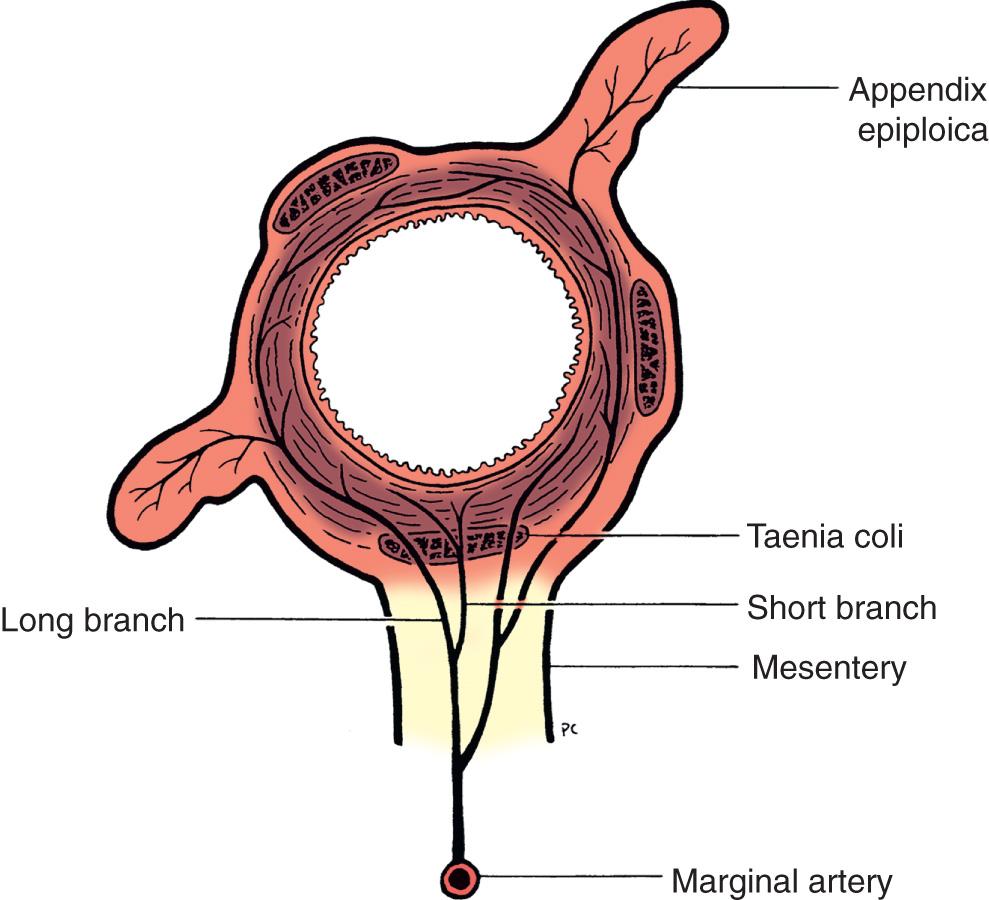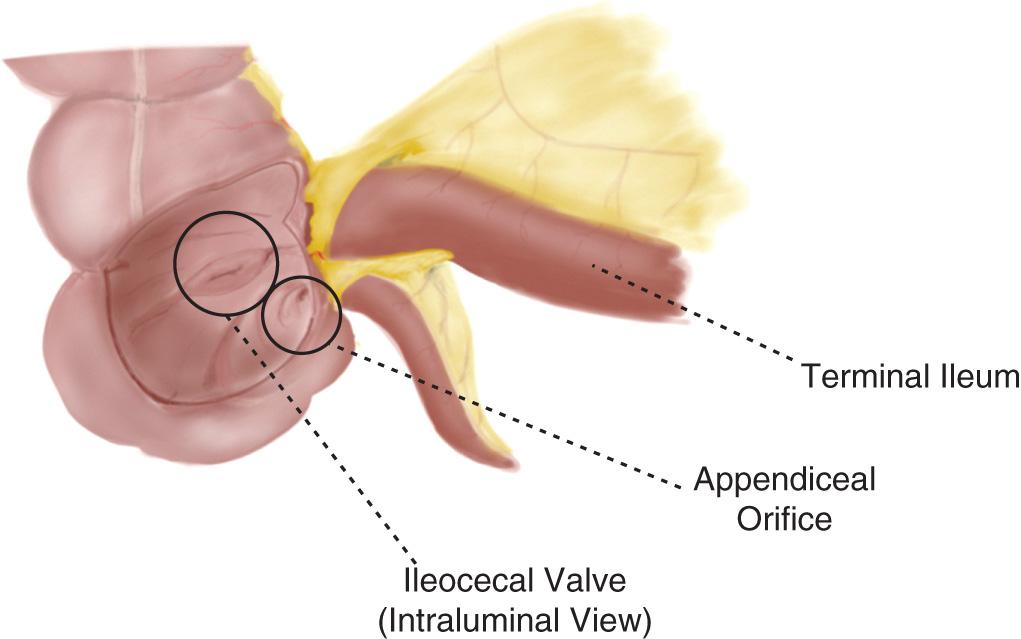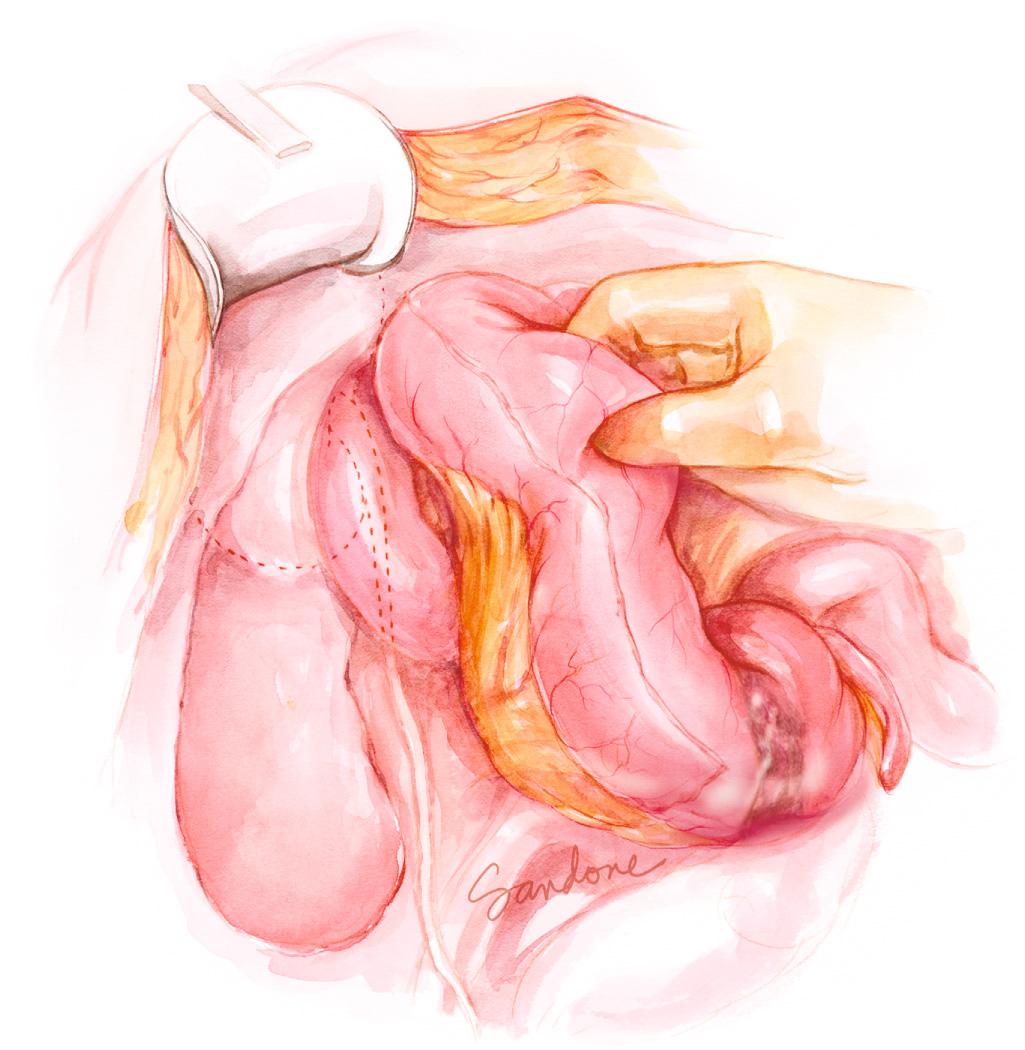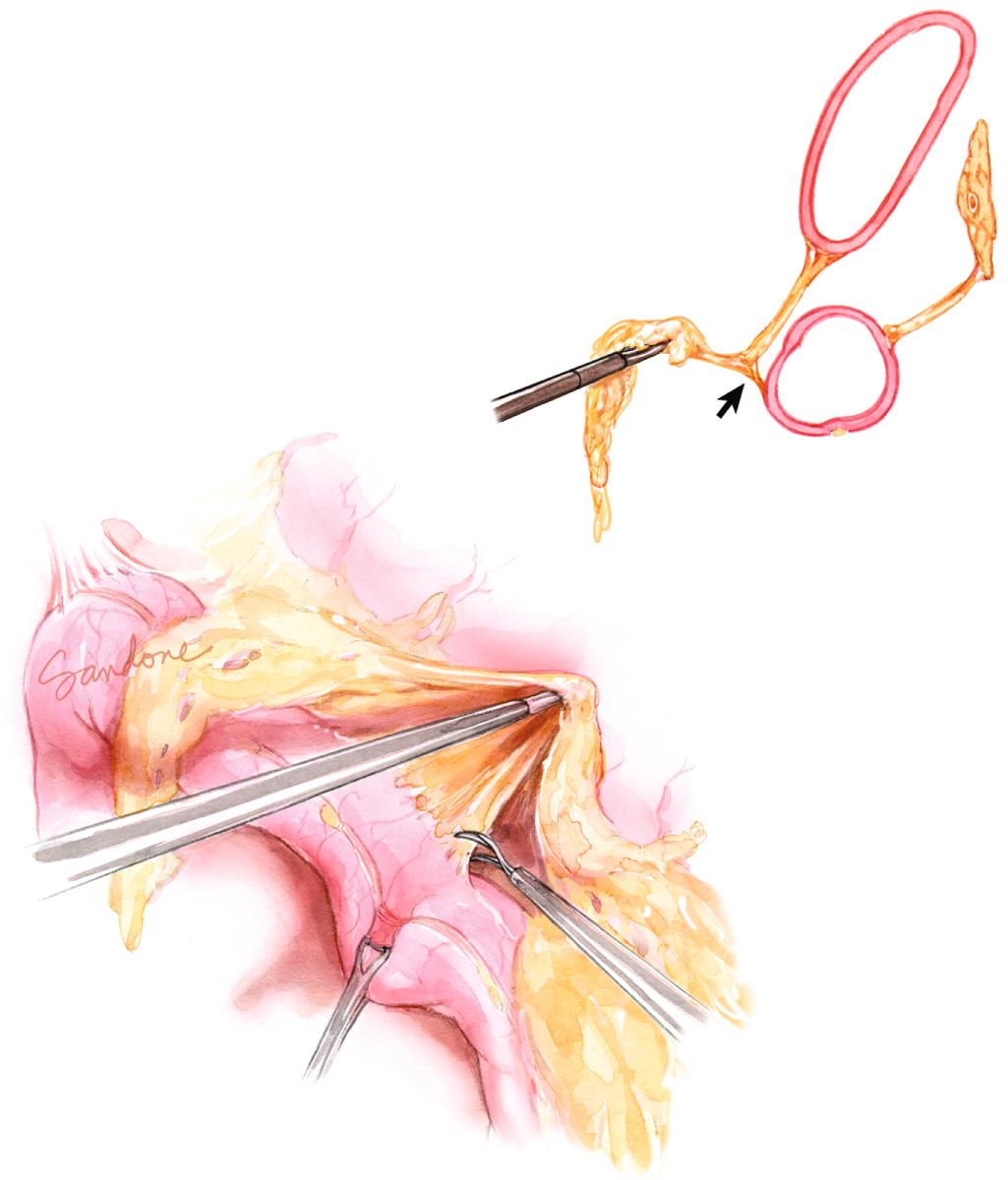Physical Address
304 North Cardinal St.
Dorchester Center, MA 02124
Knowledge of the developmental anatomy of the digestive tract is the first step in understanding operative anatomy of the colon, rectum, and anus. The surgical approach to removing portions of the digestive tract requires an understanding of the anatomical planes of the abdomen. The digestive tract begins its development around the fourth week of pregnancy as an outpouching of the pharynx and stomach forming the primitive midgut. Further progression is broken down into three stages ( Fig. 143.1 ). In the first stage, a midgut loop enters the extraembryonic coelom or yolk sac and gradually elongates into a V -shaped loop that projects ventral toward the umbilicus. This physiologic herniation of the umbilicus eventually houses a large portion of the digestive tract, including the superior mesentery artery (SMA) along with the mesentery of the bowel. The bowel resides in the umbilicus until the third trimester of pregnancy, when it gradually draws back. During this time, the intestines rotate counterclockwise around the SMA axis. During the second stage, the primitive intestine returns to the abdominal cavity. While doing so, the intestine and its mesentery rotate an additional 180 degrees counterclockwise around the SMA for a total of 270 degrees of rotation. With this rotation, the duodenum comes to lie and fuse in a location posterior to the SMA. If this rotation is incomplete, anomalies of rotation and fixation such as nonrotation, malrotation, reversed rotation, and omphalocele can occur ( Figs. 143.2 and 143.3 ). The danger with abnormal rotation and fixation is the development of an internal hernia with entrapment of the intestine, leading to acute intestinal ischemia. The third stage marks the return and fixation of the colon and its mesentery in the abdominal cavity. The colon comes to reside with the ascending and descending mesentery fused to the right and left posterolateral abdominal cavity (retroperitoneum), forming a line known as the line of Toldt . This line indicates to the surgeon where a bloodless plane exists between the mesentery of the colon and the retroperitoneum. However, when a patient has portal venous thrombosis, venous collaterals can form between the colon mesentery and the retroperitoneum making this plane hazardous. The mesentery of the transverse colon fuses with the greater omentum creating the omental bursa ( Fig. 143.4 ), an important landmark when mobilizing the colon. The cecum is the last portion of the colon to return to the abdomen. Initially it resides in the right upper quadrant; however, over time it lengthens toward the right lower quadrant, and the small bowel grows to occupy the upper and mid abdomen.
The hindgut digestive tract consists of the distal third of the transverse colon, descending and sigmoid colon, rectum, and proximal anal canal. These structures share the same arterial inflow, venous and lymphatic drainage, and autonomic innervation. In the developing fetus, the hindgut structures and the allantois merge distally and empty into a dilated collection chamber, the cloaca (Latin for “sewer”). During the 6th to 12th weeks of pregnancy, the cloaca is divided sagittally by the urorectal septum into ventral and dorsal segments. Further enfolding from the lateral walls results in caudal advancement of the dorsal segment and simultaneous involution of adjacent ectodermal-derived body wall, known as the proctodeum (or anal pit). The proctoderm and distal cloaca fuse to become the cloacal membrane. This membrane is obliterated via apoptosis, forming the dentate (pectinate) line that represents the anatomic division of hindgut/endoderm (proximal two-thirds) and the proctoderm/ectoderm (distal one-third) of the anal canal.
The common disorders that affect the hindgut include disorders of atresia and duplication. In particular, the defects associated with the anus (anorectal malformations) are classified low and high defects with regard to the relationship to the anus. In low defects, anal stenosis or atresia can present with a draining perineal fistula, whereas high defects may present with obstruction. The most common duplication disorder is the finding of mesenteric cysts that are generally located in the mesocolon or mesorectum. These cysts may or may not communicate with the intestine. Although most of these cysts are benign, they may harbor foci of malignancy. Fig. 143.5 is a pelvic duplication cyst found on incidental imaging. Hirschsprung disease or congenital megacolon is the result of the absence of ganglion cells in the myenteric plexus of the colon. It is thought to be secondary to an interruption of migration of the neuroenteric cells from the neural crest (described later in this chapter).
When development is complete, the digestive tract allows food to travel from the mouth to the anus in a musculomembranous tube approximately 9 m long. The large intestine is approximately 165 cm long and includes the cecum and appendix, ascending, transverse, descending, sigmoid colon, and rectum. The caliber of the large intestine is largest in the cecum, with a diameter of 7.5 cm, and this gradually tapers to a 2.5-cm diameter in the sigmoid colon. The colon terminates into the rectum, which is approximately 15 cm in length, and this structure continues to the anus.
The majority of the digestive tract is contained within the abdomen. The abdomen proper differs from other great cavities of the body that are bounded by muscles and fascia, allowing it to vary in capacity and shape. The understanding of these changes and their effect on human physiology are important when performing laparoscopy. The peritoneum is a serous membrane that is applied to the abdominal wall (parietal peritoneum) and viscera (visceral peritoneum). The surface of this membrane is smooth and lubricated with serous fluid that allows the viscera to freely move within the abdominal cavity. While the transverse colon and sigmoid colon are covered with visceral peritoneum, only the ventral surfaces of the ascending and descending colon and upper rectum are covered with visceral peritoneum. Given this, these portions of the digestive tract remain relatively fixed.
The wall of the colon has characteristics that are prominent on both the internal and external surface of the bowel wall. These characteristics are important in endoscopic and minimally invasive procedures to identify portions of the digestive tract. The external wall of the colon has longitudinal bands known as taenia , which cause puckering of the bowel wall to form sacculations called haustra . There are three types of taenia, named in reference to their position on the transverse colon (most prominent segment). The taenia mesocolica connect to the mesocolon; taenia omentalis, attached to the greater omentum; and the taenia libera have no attachment and are clearly visible on surface of the colon. It is between these taenia that the vasa recta brevia (small blood vessels) penetrate the colon to supply blood to the mucosa and submucosa ( Fig. 143.6 ). A weakness or outpouching of the mucosa that develops in the wall of the colon at this intersection is known as a diverticulum . The location in the colon that most frequently develops diverticular disease is the sigmoid colon. The classic triangular configuration of the transverse colon as seen during colonoscopy is secondary to these prominent taenia. Small irregular stalks of fat called appendices epiploicae are also found on the colon. They are enveloped by peritoneum and most prevalent along the taenia libera and in the sigmoid colon. The internal lining of the colon is made up of simple columnar epithelium that lacks villi. Other landmarks that distinguish the colon from other parts of the digestive tract include the ileocecal valve, a muscular valve that separates the small bowel and colon, and the appendix.

The first segment of the colon typically overlies the right iliac fossa and is covered with peritoneum. It is a saccular-shaped segment that receives the terminal ileum and serves as the origin of the appendix. In about 20% of the population, the cecum is attached to an abnormally long mesentery, resulting in a cecum that is highly mobile. Excessive mobility is one underlying factor that predisposes an individual to the development of cecal volvulus. The ileum enters the cecum along its mesenteric border and is supported by two ligaments, the superior and inferior ileocecal ligaments ( Fig. 143.7 ). Endoscopic view of the ileocecal valve reveals a transverse, narrow opening enclosed by two parallel curvilinear lips, forming a frenulum on both medial and lateral aspects. The function of the ileocecal valve is to delay transit from ileum to cecum, not necessarily to prevent reflux of contents from the cecum to ileum, and thus contrast enemas have indeterminate clinical significance. The method of achieving competency by the ileocecal valve is debatable. Kumar and Phillips believe the ileocolic ligaments and angulation of the ileum to the cecal wall achieve competency. Using cadaveric dissection on individuals with a proven competent valve, division of the ileocecal ligaments rendered the valve incompetent; ligaments were later repaired with subsequent restoration of competency. Alternatively, Pelligrini et al. demonstrated using endoscopic and surgical biopsies of the ileocecal region that this area contained both sphincter morphology and function.

The appendix arises most commonly (65%) from a retrocecal position and is between 8 and 10 cm in length and 5 and 10 mm in width. The posterior leaf of the ileal mesentery continues and joins the appendix, forming the mesoappendix. Appendiceal vessels are located within the mesoappendix. The appendix can be found in several common variant locations (pelvic, subcecal, preileal, and retroileal). Symptoms of acute appendicitis can vary due to the location of the appendix. Due to studies indicating that laparoscopic appendectomy reduces the length of stay and risk of postoperative wound infection, most patients undergo this approach. As such, the difficulties of finding a subcecal appendix through a small right lower quadrant open incision no longer exist.
The ascending colon continues cephalad from the cecum and terminates at the sharp right-to-left turn of the hepatic flexure. Throughout the course it overlies the iliacus muscle, inferior pole of the right kidney, and the retroperitoneal portion of the duodenum. The relationship between the hepatic flexure and the second portion of the duodenum is critical because it can be encountered almost unexpectedly during a hasty lateral-to-medial dissection. At its origin, the ascending colon is closely related to the anterior abdominal wall; this relationship becomes increasingly disparate as it tracks superiorly. Posteriorly, it is relatively fixed to the abdominal wall and attached laterally by the peritoneal reflection or the white line of Toldt. This line serves as a guide for the surgeon during mobilization of the ascending colon. During embryologic development, the nascent mesentery, and its lymphovascular contents, migrates posteromedially. This lateral-to-medial directionality allows safe mobilization within an avascular plane of the ascending colon mesentery, both with an open and laparoscopic approach ( Fig. 143.8 ).

The transverse colon is the longest segment of colon, averaging up to 50 cm in length. It begins at the hepatic flexure and arcs in a slight anteroinferior direction toward the splenic flexure. It is nearly completely covered by visceral peritoneum and has a deceptively more complex mesocolon, which is often closely tethered to the omentum. Because of this, laparoscopic approaches to transverse colon malignancies can be difficult when one wants to achieve an adequate lymph node harvest. The root of the mesocolon spans most of the posterior abdominal wall with attachments from the inferior pole of the right kidney to the hilum of the left kidney. The greater omentum originates from the greater curvature of the stomach, attaches to the anterosuperior transverse colon as the gastrocolic ligament, and then continues as greater omentum proper. Mobilization of the transverse colon can be accomplished by dissection of the greater omentum at the level of the gastrocolic ligament; this also provides access to the lesser sac ( Fig. 143.9 ). The transverse colon ends with a quick upward swing, juxtaposing the spleen before its descent. At the level of the splenic flexure, two ligaments relatively fix the colon: the splenocolic and the phrenocolic ligament. The splenocolic ligament arises from the inferior pole of the spleen and should be handled with care during colon mobilization. Excess traction can result in tear of the splenic capsule. If dissection is desired, the ligament should be transected as far from the spleen as feasible. The phrenocolic ligament (sustentaculum lienis) attaches to the diaphragm at about the tenth and eleventh ribs. In addition to tethering the colon, it serves as a support for the spleen.

Become a Clinical Tree membership for Full access and enjoy Unlimited articles
If you are a member. Log in here